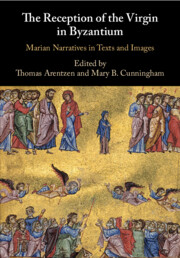15 results
Part III - Preaching her Story
-
- Book:
- The Reception of the Virgin in Byzantium
- Published online:
- 05 August 2019
- Print publication:
- 15 August 2019, pp 215-306
-
- Chapter
- Export citation
Part I - Telling Visual Stories
-
- Book:
- The Reception of the Virgin in Byzantium
- Published online:
- 05 August 2019
- Print publication:
- 15 August 2019, pp 15-148
-
- Chapter
- Export citation
Abbreviations
-
- Book:
- The Reception of the Virgin in Byzantium
- Published online:
- 05 August 2019
- Print publication:
- 15 August 2019, pp xviii-xx
-
- Chapter
- Export citation
Plates
-
- Book:
- The Reception of the Virgin in Byzantium
- Published online:
- 05 August 2019
- Print publication:
- 15 August 2019, pp vii-viii
-
- Chapter
- Export citation
Preface
-
- Book:
- The Reception of the Virgin in Byzantium
- Published online:
- 05 August 2019
- Print publication:
- 15 August 2019, pp xvii-xvii
-
- Chapter
- Export citation
Figures
-
- Book:
- The Reception of the Virgin in Byzantium
- Published online:
- 05 August 2019
- Print publication:
- 15 August 2019, pp ix-xiii
-
- Chapter
- Export citation
6 - The Dialogue of Annunciation
- from Part II - Song and Celebration
-
-
- Book:
- The Reception of the Virgin in Byzantium
- Published online:
- 05 August 2019
- Print publication:
- 15 August 2019, pp 151-169
-
- Chapter
- Export citation
Contributors
-
- Book:
- The Reception of the Virgin in Byzantium
- Published online:
- 05 August 2019
- Print publication:
- 15 August 2019, pp xiv-xvi
-
- Chapter
- Export citation
Index
-
- Book:
- The Reception of the Virgin in Byzantium
- Published online:
- 05 August 2019
- Print publication:
- 15 August 2019, pp 349-360
-
- Chapter
- Export citation
Introduction
-
-
- Book:
- The Reception of the Virgin in Byzantium
- Published online:
- 05 August 2019
- Print publication:
- 15 August 2019, pp 1-14
-
- Chapter
- Export citation
Part IV - New Narratives in the Middle Byzantine Period
-
- Book:
- The Reception of the Virgin in Byzantium
- Published online:
- 05 August 2019
- Print publication:
- 15 August 2019, pp 307-340
-
- Chapter
- Export citation
Copyright page
-
- Book:
- The Reception of the Virgin in Byzantium
- Published online:
- 05 August 2019
- Print publication:
- 15 August 2019, pp iv-iv
-
- Chapter
- Export citation
Part II - Song and Celebration
-
- Book:
- The Reception of the Virgin in Byzantium
- Published online:
- 05 August 2019
- Print publication:
- 15 August 2019, pp 149-214
-
- Chapter
- Export citation
Contents
-
- Book:
- The Reception of the Virgin in Byzantium
- Published online:
- 05 August 2019
- Print publication:
- 15 August 2019, pp v-vi
-
- Chapter
- Export citation

The Reception of the Virgin in Byzantium
- Marian Narratives in Texts and Images
-
- Published online:
- 05 August 2019
- Print publication:
- 15 August 2019



